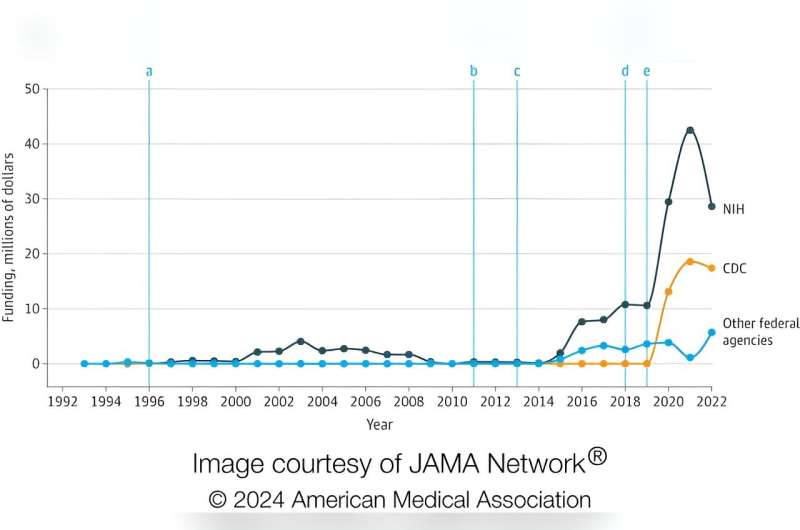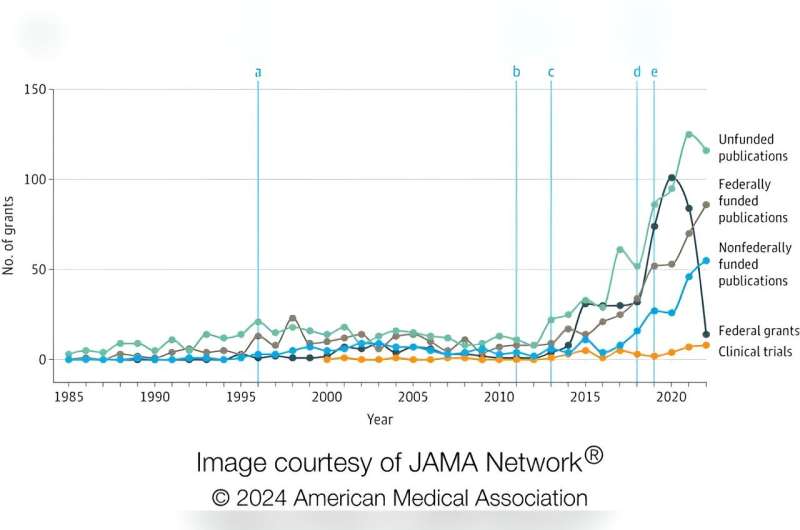This article has been reviewed according to Science X's editorial process and policies. Editors have highlighted the following attributes while ensuring the content's credibility:
fact-checked
trusted source
proofread
Lifting of federal funding ban tied to increase in gun violence research

The lifting of a two-decade drought in federal funding for firearm injury prevention research was strongly associated with an increase in both clinical trials and publications on gun violence, according to a new report published in JAMA Surgery.
For years, researchers interested in studying the causes, consequences, and prevention of firearm injury were stymied by severe restrictions on federal funding created by the passage of the Dickey Amendment in 1996.
That began to change in 2013, when the meaning of the Dickey Amendment was clarified. Small funds began to be awarded to researchers soon thereafter; and finally, in 2020, funds were reappropriated by the U.S. Congress to federal agencies like the National Institutes of Health (NIH) and U.S. Centers for Disease Control and Prevention (CDC) to increase scientists' ability to rigorously study this growing public health epidemic.
According to the new report, from 2020 to 2022 (the time since congressional appropriations restarted), the CDC and NIH awarded approximately $49 million and $100.5 million, respectively, for firearm injury prevention research. The number of registered clinical trials and research publications increased in parallel—by 90% and 86%, respectively, from 2017–2019 to 2020–2022—with a strong association between the amount of federal funding and the number of trials and publications.
The study, led by Dr. Megan L. Ranney, dean of the Yale School of Public Health, in collaboration with colleagues from Brown University, the University of Pennsylvania, and Yale School of Medicine, reviewed federal grants, registered clinical trials, and research publications related to firearm injury prevention in the U.S. between 1985 and 2022.

Of the total publications reviewed, 47% (869 articles) reported no funding; 16% (300 articles) were funded by the NIH; 11% (197 articles) by the CDC; and 38% (706 articles) by other sources such as private philanthropic organizations. The fact that many researchers published studies without federal funding support illustrates the motivational impact and compounding effect a robust federal funding environment can have on the science community, Ranney said.
"This study clearly shows that federal funding is a motivator and legitimator for investigators interested in firearm injury prevention," said Ranney, who is a also an emergency physician.
Most studies (55%) assessed community firearm violence; 48% of the studies focused on firearm suicides; and 21% investigated unintentional firearm injuries. Annual federal funding amounts positively correlated with the number of publications overall, the researchers said.
While the increase in scientific reports and intervention studies may partly be attributed to the current national gun violence crisis in the U.S., the role and impact of sustained federal funding in supporting firearm injury prevention research cannot be understated, Ranney said.
"This study shows that as rates of firearm injuries and death rise in the U.S., continued federal funding is critical for supporting and facilitating rigorous research and data-driven solutions," said Ranney.
"Research helps us understand what works and helps us invest our time and money in programs that will really make a difference. Already, CDC- and NIH-funded research has shown the value of some innovative new programs, such as the 'See Something Say Something' program. But more is needed."
More information: John C. Lin et al, Trends in Firearm Injury Prevention Research Funding, Clinical Trials, and Publications in the US, 1985-2022, JAMA Surgery (2024). DOI: 10.1001/jamasurg.2023.7461





















